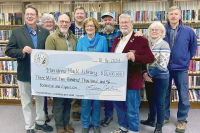Recommended diversions
Albert Race Sample, aka “RACEHOSS.”
(Instead of listing several diversions, I have decided to devote the entire column to a single recommendation. Certainly, “Racehoss” deserves no less.)
Recently, some friend of mine told me that they had just heard (and seen) “the world’s greatest storyteller” perform in an amazing two-hour documentary film. Admittedly, such praise sounded excessive, but when I asked where I could get it, a friend named Mike Barbee over in Brevard gave me a copy.
I watched “Racehoss” with four friends recently, and I believe I can speak for all of us. For sheer power, emotional impact and masterful performance, Albert Race Sample is the best I have ever seen or heard.
An Afro-American with a face that resembles a ravaged landscape, the 72-year-old Albert “Racehoss” Sample gives a graphic account of the neglect and casual violence visited on him by his prostitute-mother and alcoholic father.
“The first time I went to jail, I was 4 years old,” says Racehoss. “It was fun.” Imprisoned for stabbing a teacher, Albert exchanged prison for the army barracks but found the same impersonal violence to “the misfits.” After that, he lived in boxcars for a while where he invariably encountered Texas law enforcement and jail. Judged to be a “social reject,” hopeless and unredeemable, he ends up in prison again (a 30-year sentence) where he endures torture and daily brutality until his parole in 1974.
Against all odds, Racehoss becomes a parole officer for the Texas penal system and devotes the rest of his life working to reform the system that had victimized him. Until his death last year, he toured the United States — a one-man-show who could hold an audience spellbound as he recounts his life. Audiences frequently state that they came away with the distinct feeling that they have been transported to a campfire where a master storyteller has held them spellbound.
Essentially, Albert’s story is one of hatred, hope and redemption; it is told in the raw (and frequently obscene) vernacular of his world. (In Albert’s mouth, obscenities become a kind of poetry.)
Special credit goes to the filmmaker, Sean Hepburn (son of Audrey Hepburn), who uses high definition film to capture the subtle changes in Racehoss’ remarkable face — as well as the bleak features of his world: railroad tracks, prison yards, shacks, cotton fields, etc.
“Racehoss: Big Emma’s Boy” is still hard to get, although there is talk of an HBO release in the near future. At present it is available on DVD on the “Racehoss” Web site. There is also a “streaming” version that is available free on the Internet. The 1984 book, Racehoss: Big Emma’s Boy, is hard to find but it is out there.
— By Gary Carden





